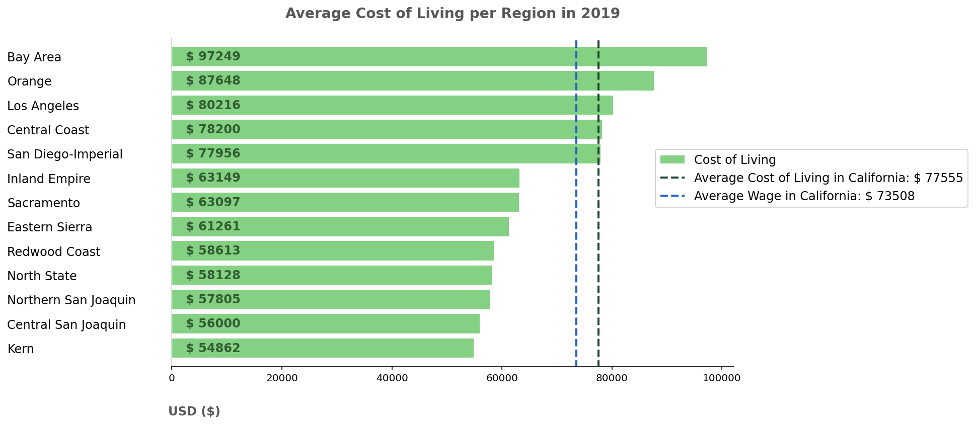
(Photo: WOCinTech Chat/Flickr)
How well are California’s regions doing in producing higher wage jobs? In the decade after the Great Recession, approximately 60% of the jobs created across the state paid less than $18 dollars an hour.
California Forward has developed a new measure of higher wage jobs to examine economic performance across the state’s regions and help benchmark progress. This supplemental measure calculates the number of higher wage jobs in various industries across the state and within its regions as defined by California’s Community Economic Resiliency Fund (CERF) initiative, which is supporting the development of regional economic roadmaps.
A higher wage job is one that earns an income sufficient to meet the cost of living needed to sustain a household with one adult and two children, one older and one younger. That income threshold is regionally adjusted to reflect the varying cost of living across California and was set by the United Way of California.
The following chart shows the percentage of jobs that are higher wage jobs in a given region in 2019. Notably areas of Inland California with a lower cost of living do relatively well. In terms of the percentage of all employment, the Sacramento region had the highest rate of higher wage jobs at 43%, while the Los Angeles region had the lowest, at 23%.
 In terms of the absolute number of higher wage jobs, the Bay Area had the highest number, at 1,223,689 higher wage jobs, while the Redwood Coast region had the lowest, at 13,168 higher wage jobs. The following chart shows the relative number of higher wage jobs by each region through the size of the box in the treemap. The color of the region’s area corresponds to the percentage of jobs that are higher wage in the region – the darker the color, the higher the percentage of higher wage jobs.
In terms of the absolute number of higher wage jobs, the Bay Area had the highest number, at 1,223,689 higher wage jobs, while the Redwood Coast region had the lowest, at 13,168 higher wage jobs. The following chart shows the relative number of higher wage jobs by each region through the size of the box in the treemap. The color of the region’s area corresponds to the percentage of jobs that are higher wage in the region – the darker the color, the higher the percentage of higher wage jobs.

These higher wage jobs should be looked at alongside each region’s respective cost of living, found in the next plot. Overall, the cost of living in California was $77,555 in 2019, according to the United Way of California, while the average wage in California was $73,508 in 2019.
 There are also pronounced differences in who holds higher wage jobs across California’s demographics. Over 32% of employed multiracial Californians, 34% of Asian Californians and 39% of white Californians work in higher wage jobs. Compare that to 20% of employed Native Americans in California, 19.5% of employed black Californians, and 15% of employed Latino Californians work in higher wage jobs.
There are also pronounced differences in who holds higher wage jobs across California’s demographics. Over 32% of employed multiracial Californians, 34% of Asian Californians and 39% of white Californians work in higher wage jobs. Compare that to 20% of employed Native Americans in California, 19.5% of employed black Californians, and 15% of employed Latino Californians work in higher wage jobs.
By comparing the number of higher wage job across California’s diverse regions, policymakers and sector leaders have an opportunity to take stock of their region and new and existing efforts to improve the economic mobility of residents.
One such recent effort is already underway with regions engaged in the State of California’s new $600-million Community Economic Resilience Fund (CERF) program, which will support inclusive regional economic plans that invest in industries that will thrive in a carbon-neutral future, create high-quality jobs, and build a more equitable economy. California Forward has been working with regional coalitions to bring together leaders and support the regions’ progress as their CERF applications move forward.
California Forward also recently captured lessons and best practices of collaborative efforts from across California’s regions to generate more high-paying and promising jobs that create social equity and environmental sustainability.
Additionally, at the 2022 California Economic Summit, participants will consider how to target historic investments in the state’s education and workforce systems to address short-term needs while building the political will to fundamentally transform the system into one that is better connected and more equitable.
The Summit’s Education and Workforce work group is building on its previous work to develop an agenda for leveraging state policy and regional practice to achieve a better aligned and more cohesive lifelong learning system and get more people into higher-paying jobs in all regions.
This measure utilizes U.S. Census Bureau Microdata and monthly employment figures from the California Employment Development Department. Higher wage income thresholds utilize the United Way Real Cost of Living measure. The methodology to calculate these specific higher wage jobs indices is available here. The code calculating the higher wage jobs created is open source and available here.

